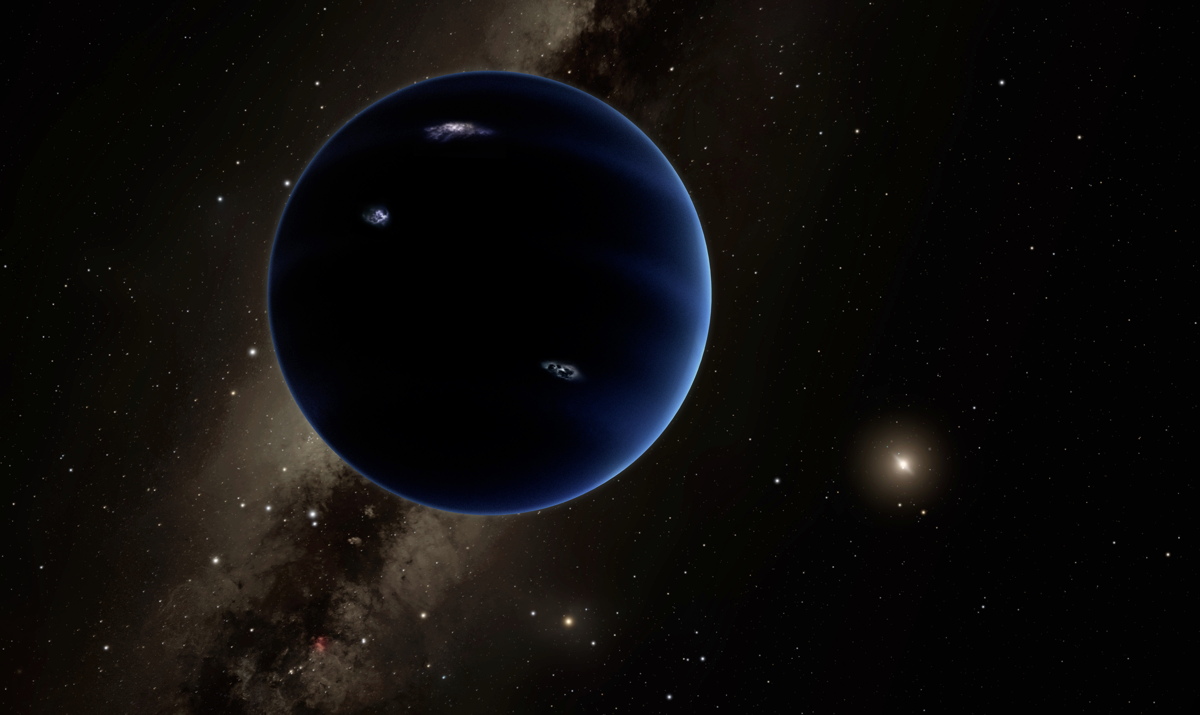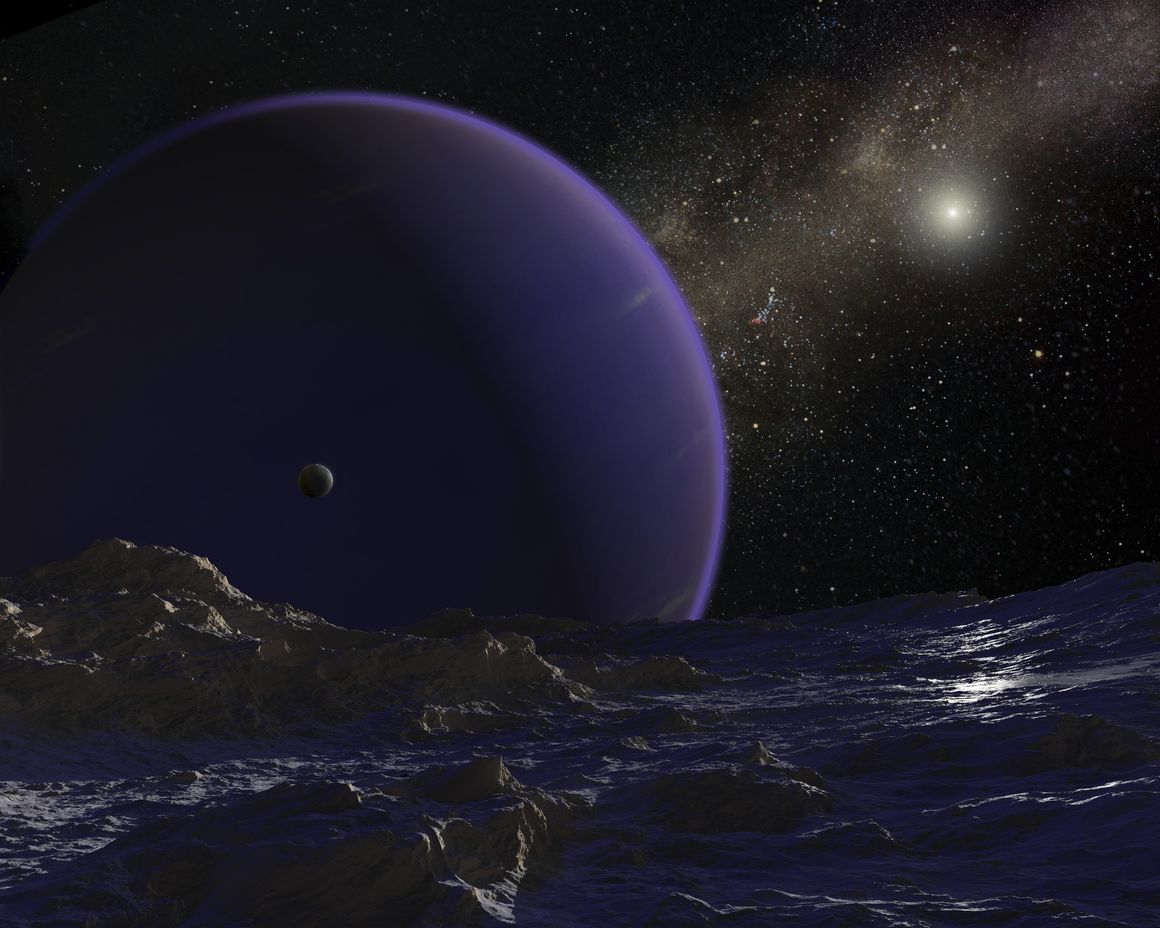Article #001: Hidden Ninth Planet
Published: 01/10/2023

Artist's illustration of Planet Nine, that has been newly discovered in the far outer solar system. (Image Credit: Caltech/R. Hurt (IPAC))
In January 2015, Caltech researchers and astronomers Konstantin Batygin and Mike Brown found mathematical evidence suggesting there may be a "Planet X" deep in the solar system. This would bring the number of planets in our universe to a count of 9 (excluding pluto). The researchers nicknamed the hypothetical planet as "Planet Nine". "Planet Nine" is calculated to be around the size of Neptune (10x bigger than Earth) and orbiting 20 times farther from the Sun than Neptune on average. This means that Planet 9 may take between 100 - 200 Earth centuries to make one full orbit around the Sun.
Details
The astronomers from Caltech have based their evidence of the existence of Planet 9 to be solely based on detailed mathematical modeling and computer simulations, rather than direct observation. This large object explains the unique orbits of some smaller objects discovered in the distant Kuiper Belt.
They noticed some dwarf planets and comets tend to follow orbits that cluster together. By analyzing and measuring these orbits, the Caltech team predicted the possibility that a large planet beyond Pluto might exist.
Astronomers and Researchers are now using extremely powerful telescopes to search for the object in its predicted orbit. It turns out that planets at such a large distance from the Sun look very faint and almost invisible.
Terminology
- Perihelia = The point nearest to the sun in the path of an orbiting celestial body.
- Inclination = Change in direction of regular orbit path.
- Semi-major Axis = Half of the longest diameter of an ellipse (in our case, the objects orbit path is the ellipse).
- Trans-Neptunian object (TNO) = Any minor planet in the solar system that orbits the Sun at a greater average distance than Neptune (30.1 AU semi-major axis).
- Extreme trans-Neptunian object (ETNO) = A trans-Neptunian object orbiting the Sun well beyond Neptune in the outermost region of the solar system.
Evidence
The gravitational influence of Planet Nine would explain these abnormalities of the Solar System:- Extreme Trans-Neptunian Object (ETNOs) orbit clustering formation.
- High perihelia of objects like 90377 Sedna that are detached from Neptune's influence.
- High inclinations of ETNOs with orbits roughly perpendicular to other known planets of our solar system.
- High inclination of smaller trans-Neptunian objects (TNOs) with semi-major axis less thn 100 AU.
Planet Nine modifies the orbits of ETNOs with a combination of effects.
On long-term scales, Planet Nine exerts a torque on the orbits of the ETNOs
depending on the alignment of the two orbits. The angular momentum causes the perihelia to rise, placing them in Sedna-like orbits, and then fall back into place
millions of years later.
On short-term scales, the gravity of Neptune and the other giant planets, and the inclination of Planet Nine's orbit, weaken the ETNOs phase protection resulting
in a chaotic variation of semi-major axes.
Research
Detection Attempts
Since Planet Nine is at a very far distance from the Sun, it would reflect very little sunlight, potentially evading telescope sightings.
It is estimated to have fainter light than an apparent magnitude of 22. However, if Planet Nine comes close to perihelion, astronomers could identify it based on
existing images.
Researchers have concluded that the Subaru Telescope is the most optimal way of trying to capture Planet Nine because it is predicted to be visible in the Northern Hemisphere. The Subaru Telescope has an aperture large enough to see faint objects and a wide-field of view to shorten the search across the night sky. Even though Planet Nine reflects very little sunlight, due to its large mass and lack of atmosphere, it still radiates the heat from its formation as it cools. This allows researchers to look for Planet Nine by looking for infrared wavelengths in distant outer regions of the solar system.
Attempts at predicting location
Cassini, a satellite that orbits Saturn, suggests that there have been disruptions and inclinations in Saturn's orbit. Researchers claim that Planet Nine could be affecting these orbits. However, this doesn't provide enough evidence to prove th existence of Planet Nine.
Using Batygin and Brown's observed parameters for Planet Nine, computers suggest that Planet Nine is approximately 630 AU from the Sun on average, has declination close to −20°, and a right ascensions close to 2^h. A later analysis of Cassini data tightened the constraints on possible locations of Planet Nine by using more accurate parameters and key discoveries from other observations. It is officially concluded that Planet Nine is most likely to be located within 20° of RA = 40°, Dec = −15°, in an area of the sky near the constellation Cetus.
According to Wikipedia, in May 2022, it was suggested that the peculiar meteor CNEOS 2014-01-08 may have entered Earth-crossing orbit after a swing-by of Planet Nine. If that hypothesis is true, the trajectory back-tracing of CNEOS 2014-01-08 means Planet Nine may be currently located in the constellation of Aries, at right ascension 50±4.1°, and declination 11.8±1.8°.

Artist's illustration of Planet Nine from a fictional (but possible) moon. (Image Credit: Steven Hobbs/Stocktrek Images)
Written by BooleanCube :]